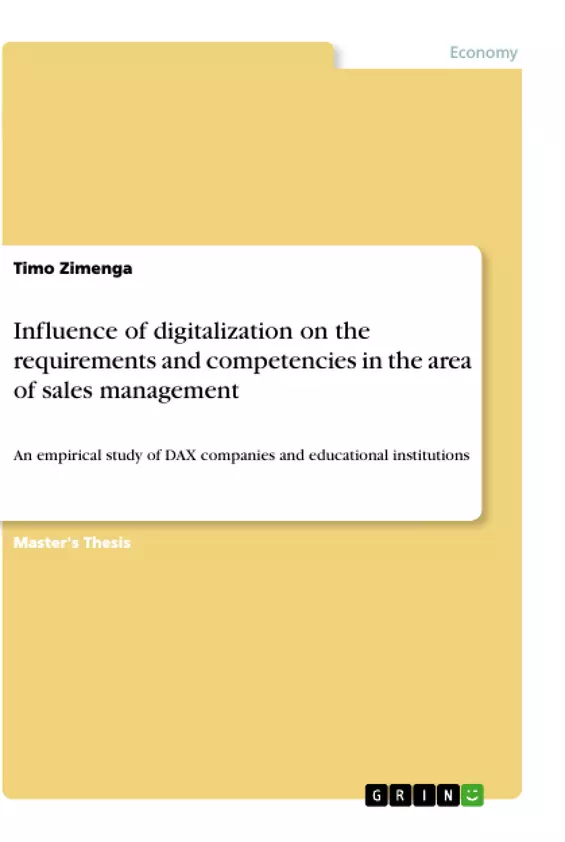Can humans be replaced by robots or intelligent systems such as artificial intelligence? Are they becoming less important because of the digital revolution? Are humans changing in terms of the orientation of their competences, also due to the effects of the digital revolution? These questions are often asked in the context of the work between man and machine.
In order to find about more about a possible change in competences, caused by the effects of the digital revolution, this Master thesis deals with the
“Influence of digitalization on the requirements and competencies in the area of sales management
An empirical study of DAX companies and educational institutions”
First of all, a basic theoretical knowledge will be provided in order to work on and answer this topic. On the one hand, the digital transformation, the area of leadership and on the other hand the area of competence takeover by intelligent systems will be presented. To collect and evaluate data, an empirical study was conducted at DAX companies and Germany's leading universities and colleges in order to be able to identify possible shifts in competence on the basis of valid data.
The result of the empirical analysis is a competence structure, which results in an interesting form. The study has shown that, contrary to expectations, the technical and IT-heavy competences as well as the competences related to the digital revolution are not as important for leaders as other competences, such as personal, ethical and social-communicative competences, which are important for leaders acting in the digital age.
This and other results, such as the distribution within the competence classes and whether a competence shift from man to machine and other intelligent systems is possible, are presented in the final part of this Master thesis.
Inhaltsverzeichnis (Table of Contents)
- Executive Summary
- Table of Contents
- List of Abbreviations
- List of Figures
- List of Tables
- Introduction
- Relevance of the topic
- Problem and objective target
- Course of action & Methodology
- A theoretical approach
- Digitalization as a mega trend
- Industry 4.0
- Digital transformation
- Artificial intelligence
- Cyber-physical systems
- Leadership
- Definition
- Leadership 4.0 – Expected changes due to digitalization
- Competences
- Displacement of competences from human to intelligent system
- Intermediate conclusion
- Digitalization as a mega trend
- Empirical study
- Research questions & topics
- Questionnaire
- Target group
- Operationalization
- Development
- Pretest
- Implementation
- Type of evaluation
- Result evaluation
- Summary of collected data
- Evaluation and testing of research topic
- Results from literature review
- Data analysis combined as overview
- Data analysis of the companies
- Data analysis of the educational institutes
- Data analysis of the most important competences
- Discussion
Zielsetzung und Themenschwerpunkte (Objectives and Key Themes)
This Master thesis examines the influence of digitalization on the requirements and competencies in the area of sales management. It explores the question of whether digital transformation is causing a shift in necessary competencies from human to intelligent systems. The research focuses on analyzing data collected from DAX companies and leading German universities and colleges to identify potential shifts in competence requirements.
- The impact of digitalization on sales management competencies
- The role of artificial intelligence and cyber-physical systems in shaping leadership styles
- The potential displacement of human competences by intelligent systems
- The importance of personal, ethical, and social-communicative skills in the digital age
- The development of a competence structure for effective leadership in the digitalized sales environment
Zusammenfassung der Kapitel (Chapter Summaries)
The thesis begins with an introduction that highlights the relevance of the topic and outlines the research problem and objectives. Chapter 2 provides a theoretical framework, exploring digitalization as a mega trend, including Industry 4.0, the digital transformation, artificial intelligence, and cyber-physical systems. It then delves into the concept of leadership, defining it and examining the expected changes due to digitalization, known as Leadership 4.0. This chapter concludes by exploring the displacement of competences from humans to intelligent systems.
Chapter 3 details the empirical study conducted, outlining the research questions, the questionnaire used to collect data from DAX companies and educational institutions, and the type of evaluation employed. Chapter 4 presents the result evaluation, summarizing the collected data and analyzing the findings. It discusses the results from the literature review, combines data analysis for a comprehensive overview, and presents separate analyses for the companies and educational institutes. The chapter concludes with an analysis of the most important competences identified.
Finally, Chapter 5 offers a discussion of the research findings, exploring the implications of the study's results.
Schlüsselwörter (Keywords)
This thesis explores the intersection of digitalization, sales management, competence requirements, leadership, artificial intelligence, cyber-physical systems, and the potential displacement of human competencies by intelligent systems. The research uses empirical data collected from DAX companies and leading German universities and colleges to analyze the impact of digitalization on sales management practices and the evolving role of leadership in a digitalized environment.
- Quote paper
- Timo Zimenga (Author), 2020, Influence of digitalization on the requirements and competencies in the area of sales management, Munich, GRIN Verlag, https://www.grin.com/document/920755



